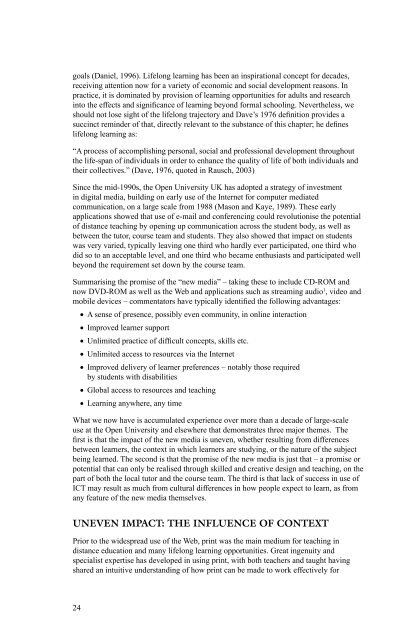lifelong learning and distance higher education - Asia Pacific Region
lifelong learning and distance higher education - Asia Pacific Region
lifelong learning and distance higher education - Asia Pacific Region
- No tags were found...
You also want an ePaper? Increase the reach of your titles
YUMPU automatically turns print PDFs into web optimized ePapers that Google loves.
goals (Daniel, 1996). Lifelong <strong>learning</strong> has been an inspirational concept for decades,receiving attention now for a variety of economic <strong>and</strong> social development reasons. Inpractice, it is dominated by provision of <strong>learning</strong> opportunities for adults <strong>and</strong> researchinto the effects <strong>and</strong> significance of <strong>learning</strong> beyond formal schooling. Nevertheless, weshould not lose sight of the <strong>lifelong</strong> trajectory <strong>and</strong> Dave’s 1976 definition provides asuccinct reminder of that, directly relevant to the substance of this chapter; he defines<strong>lifelong</strong> <strong>learning</strong> as:“A process of accomplishing personal, social <strong>and</strong> professional development throughoutthe life-span of individuals in order to enhance the quality of life of both individuals <strong>and</strong>their collectives.” (Dave, 1976, quoted in Rausch, 2003)Since the mid-1990s, the Open University UK has adopted a strategy of investmentin digital media, building on early use of the Internet for computer mediatedcommunication, on a large scale from 1988 (Mason <strong>and</strong> Kaye, 1989). These earlyapplications showed that use of e-mail <strong>and</strong> conferencing could revolutionise the potentialof <strong>distance</strong> teaching by opening up communication across the student body, as well asbetween the tutor, course team <strong>and</strong> students. They also showed that impact on studentswas very varied, typically leaving one third who hardly ever participated, one third whodid so to an acceptable level, <strong>and</strong> one third who became enthusiasts <strong>and</strong> participated wellbeyond the requirement set down by the course team.Summarising the promise of the “new media” – taking these to include CD-ROM <strong>and</strong>now DVD-ROM as well as the Web <strong>and</strong> applications such as streaming audio 1 , video <strong>and</strong>mobile devices – commentators have typically identified the following advantages:• A sense of presence, possibly even community, in online interaction• Improved learner support• Unlimited practice of difficult concepts, skills etc.• Unlimited access to resources via the Internet• Improved delivery of learner preferences – notably those requiredby students with disabilities• Global access to resources <strong>and</strong> teaching• Learning anywhere, any timeWhat we now have is accumulated experience over more than a decade of large-scaleuse at the Open University <strong>and</strong> elsewhere that demonstrates three major themes. Thefirst is that the impact of the new media is uneven, whether resulting from differencesbetween learners, the context in which learners are studying, or the nature of the subjectbeing learned. The second is that the promise of the new media is just that – a promise orpotential that can only be realised through skilled <strong>and</strong> creative design <strong>and</strong> teaching, on thepart of both the local tutor <strong>and</strong> the course team. The third is that lack of success in use ofICT may result as much from cultural differences in how people expect to learn, as fromany feature of the new media themselves.UNEVEN IMPACT: THE INFLUENCE OF CONTEXTPrior to the widespread use of the Web, print was the main medium for teaching in<strong>distance</strong> <strong>education</strong> <strong>and</strong> many <strong>lifelong</strong> <strong>learning</strong> opportunities. Great ingenuity <strong>and</strong>specialist expertise has developed in using print, with both teachers <strong>and</strong> taught havingshared an intuitive underst<strong>and</strong>ing of how print can be made to work effectively for24
















